Orano la Hague

Orano la Hague, on the cutting edge of used fuel recycling
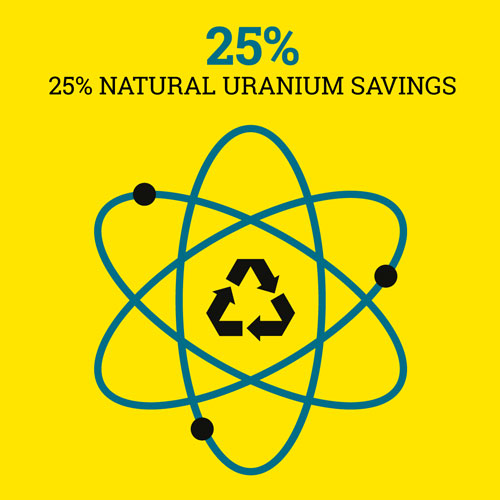
Orano la Hague, a major player in used nuclear fuel recycling
The treatment of used nuclear fuel is a long production cycle which lasts about 10 years. It begins when the used fuel is removed from the nuclear reactors where it produced power. The fuel is then packaged in “casks”, which are steel containers
weighing 110 metric tons (for 10 metric tons of materials), so that it can be safely shipped. Then it is ready to be shipped to the Orano la Hague site, some 25 kilometers from Cherbourg in the MancheDepartment, where it will be treated. And so begins
a great adventure…
The complete story of the great transformation of used nuclear fuel

Upon arrival at the la Hague site, the fuel is removed from the cask. This intricate operation is performed completely remotely using specialized robots and remote manipulators.
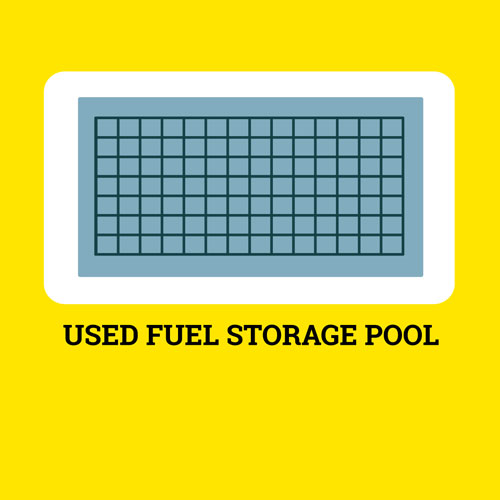
After this first bath, the fuel is cut up into small pieces for its second bath in a nitric acid solution to dissolve its nuclear material. The recyclable material is separated from the non-recyclable material and waste in a chemical facility.
At the end of these operations, 96% of the material can be recycled. Of this, 95% is uranium and 1% is plutonium.
The remaining 4% consist of fission products, also called final waste.
The uranium and plutonium are separated in turn for treatment in a series of complex chemical operations. The uranium will become uranyl nitrate and the plutonium will be converted into plutonium oxide. The latter will be used to produce fresh fuel called
MOX – mixed oxides of uranium and plutonium – to reduce our natural uranium requirements by 25%. Meanwhile, the uranium is held as a strategic inventory pending re-enrichment.
What happens to the final waste?
This waste cannot be reduced further; it is calcined and mixed with glass, then melted and poured into stainless steel canisters, offering safe and stable immobilization for several tens of thousands of years.
If the waste comes from French reactors, it is stored at the Orano la Hague site in buildings constructed for that purpose pending transfer to the final disposal facility to be built under the Cigéo Project.
If it comes from abroad, it is returned to the country of origin, as required by French law.
Orano la Hague, Number 1 in nuclear materials recycling
Orano La Hague is:
34,000 metric tons of used fuel treated since the site's creation.
4,000 Orano employees + 1,000 subcrontrator personnel
300 hectares
EDF, the world’s leading nuclear operator, ships the used fuel from its 58 reactors in France to Orano la Hague, making it the site’s largest customer. At the same time, la Hague has treated fuel from far away, and sometimes from very far away places such as Australia, for more than 40 years. La Hague has customers on 5 continents, with most of its business concentrated in Western Europe (Germany, Switzerland, Belgium, Italy and the Netherlands) and in Asia (China and Japan).
Orano la Hague also provides safe radioactive materials transportation via its subsidiary Orano TN. The final waste is returned to its country of origin after treatment. These operations are certified under the ISO 14001 environmental standard and the ISO 9002 quality management standard.
An innovative site that serves as inspiration for other countries
The
technologies developed and managed by Orano la Hague are an inspiration
to a number of foreign countries. A number of visits organized to
discover the know-how deployed at the site, and some 3,000 visitors were
received in our facilities in 2016.
The Orano la Hague site is the
global benchmark for the construction of other recycling centers around
the world.
The used fuel treatment plant at the Rokkasho-Mura site in Japan is the fruit of technology transfer from Orano. It is scheduled to enter service soon. China, which is building the world’s leading nuclear power program, has also opted to build used fuel treatment facilities suited to its domestic requirements. It might choose Orano’s technology perfected at the la Hague site for its future treatment plant.
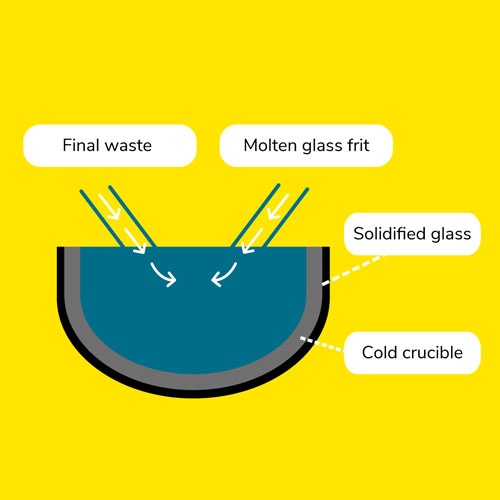
Vitrification by induction in a cold crucible consists of heating the glass that separates the liner from the glass containing the final waste, rather than the liner itself. The walls of the crucible are cooled with a system of circulating water.
By staying cool, the crucible is protected from the very high temperatures and corrosion, multiplying its service life by ten! Moreover, the vitrification throughput rates are increased with this innovation, and legacy fission products can be processed.
Did you know?
Cold crucible induction vitrification:
• 25 years of research and development
• 2010, the first year of service
• More than 1,000 canisters of vitrified waste produced
La Hague, an intensively monitored site:
Due to the nature of its operations and the volumes of fuel treated, the la Hague site, where 5,000 people work, is intensively monitored at all times.
Safety is an integral component of all of Orano la Hague’s processes:
Reducing the risks of a nuclear accident and ensuring the safety of employees and of infrastructure are constant concerns for the Orano la Hague site. The measures taken are part of a continuous improvement initiative that has been carried out for several years. Every year, site personnel participate in emergency drills to raise awareness of the risks and to be ready to cope with critical situations.
The Site and Materials Protection Brigade includes response personnel trained in the site’s specific hazards (fire, chemical or radioactive leaks, etc.). The human and equipment response resources are equivalent to those of a city of 30,000 inhabitants! In addition, the Orano la Hague site is monitored by the Nuclear Safety Authority (ASN), which regularly performs inspections.
Zero impact: environmental impacts close to that of natural radioactivity
Ensuring that operations have no impact on the environment is another of Orano la Hague’s priorities. Every day, dozens of samples are taken from the environment and analyzed to verify that the radioactivity of the products treated at the site remains under control. The results of these measurements indicate that the radioactivity from the operations of Orano la Hague is below the natural radioactivity of the region.

Orano is planning for the future in Normandy
Based in Normandy for 50 years, the Orano la Hague site is the global benchmark in used nuclear fuel treatment and recycling. The group is the leading employer in the Cotentin Peninsula, with nearly 4,800 employees of varying backgrounds, whether in nuclear safety, engineering, facility operations, mechanical.

Orano’s presence in the Cotentin Peninsula is led by several entities with a total of approximately 4,800 employees (under open-ended or fixed-term contracts).
- Orano la Hague: ≈ 3,000 employees
- Orano Temis, based in Valognes, Beaumont-Hague and Saint-Sauveur-le-Vicomte ≈ 370 employees • Orano Projects, based in Equeurdreville ≈ 700 employees
- Palova: logistics platform at Valognes ≈ 200 employees
- Orano DS and its subsidiaries, based in Beaumont-Hague ≈ 500 employees
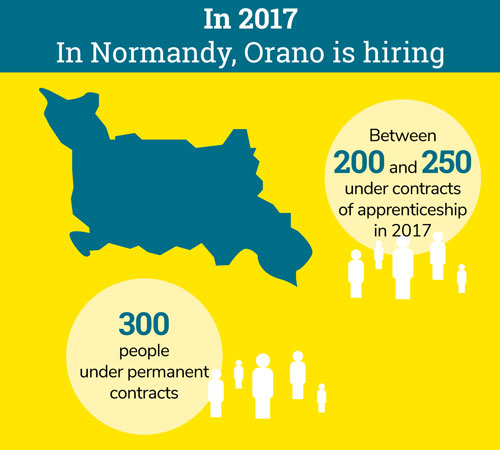
Business: visibility through 2040
La Hague’s treatment and recycling operations are part of a commitment between Orano and EDF until 2040. The volumes involved are defined in specific agreements. The most recent agreement, signed in 2015, gives the site renewed visibility and workload, with annual production of 1,100 metric tons until 2022 and an unprecedented level of investment.
2015-2022: a major capital spending plan
Considerable capital expenditure has been committed to ensuring the safety and long-term operation of the facilities in recycling as well as in dismantling.
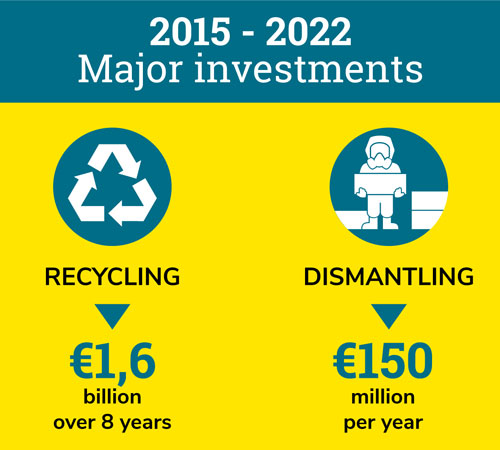
Recycling:
1.6 billion euros in capital expenditure over an eight-year period, i.e. approximately 200 million euros per year.
Dismantling:
- 150 million euros per year on the construction of facilities dedicated to legacy waste retrieval and packaging
- 50 million euros per year for cleanup and dismantling operations.
Close-up on major capital spending projects
- Continuity of site operations:
The New Fission Production Concentration Unit Project (NCPF) will replace existing evaporators with new equipment at the two extraction facilities for uranium, plutonium and fission product separation.
Another major project is the construction of new extensions to the storage units for vitrified waste canisters (EEVLH2) and for compacted metal waste (E-ECC). - Facility safety:
As part of the post-Fukushima supplementary safety assessments (SSA), Orano continues to install emergency management centers at its main sites; they will be used to manage a crisis with complete autonomy for 48 hours, regardless of the magnitude of the seismic event or extreme weather. Objective: to bring together the resources needed to restore fundamental safety functions under extreme circumstances. Several milestones have been met at the la Hague site: startup of the Storage Block (practically a safe, where mobile remediation equipment and vehicles are kept), receipt of “hardened core” equipment (mobile pumps, filtration and distribution cradles, generators) and verification of the proper operation of the cooling water feed system for the site. In 2017, construction of the Command Block has begun and remediation tests has been completed. - Waste retrieval and packaging (RCD):
Construction continues on facilities for the retrieval of legacy waste produced by the treatment operations of the UP2-400 plant at la Hague, currently undergoing dismantling. This waste had been stored on site pending the availability of an appropriate packaging and disposal method. - Special fuel treatment (TCP):
The project to industrialize special fuel treatment operations using existing facilities aims to offer operators and customers proven and competitive solutions in the back end of the fuel cycle. - Long-standing support for regional economic development:
For decades, Orano has been involved in numerous economic development programs in Normandy at the regional, departmental and local levels. Objective: to support jobs in the nuclear industry as well as in other industries present across the region.
An example at the regional level is Nucleopolis, the regional nuclear industry cluster in Normandy, which Orano supports by contributing skills. The group also sponsors the Fast Forward business accelerator (FFWD) and the first recipients of the regional Exc’op label aimed at identifying supplier skills in operational excellence at the la Hague site.
Did you know?
Orano la Hague has received the Excellence Award from the Japan Institute of Plant Maintenance.
In 2016, Orano launched a revitalization plan in the Manche area which provides guaranteed loans and supplies skills to eligible companies.
The revitalization plan has a budget of 507,000 euros which will be injected into the local economy to create jobs over a period of three years.
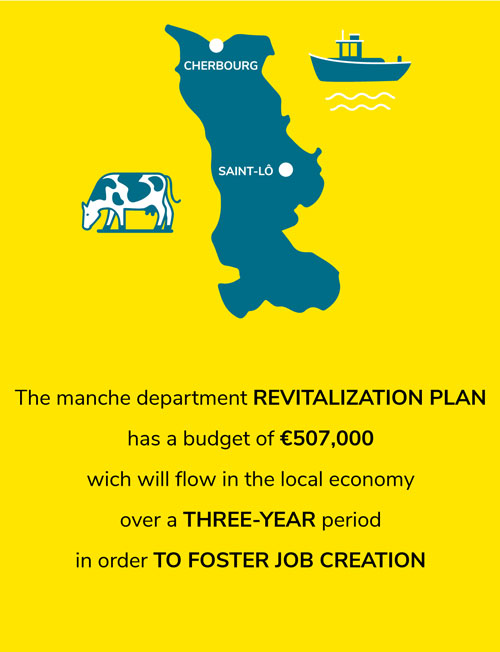
Through all of these programs, Orano plans to remain an important economic player in Normandy and to take positive action for the future through forward-looking investments in the region.
